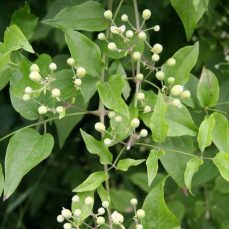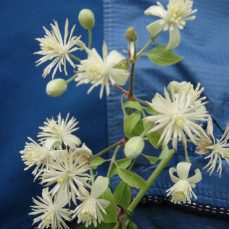Wild Clematis (Clematis vitalba)

Photo credit: Jan Samanek, Phytosanitary Administration, Bugwood.org
Management Strategy
Squamish
Whistler
Pemberton
Vectors of Spread
Overview
Wild clematis is a deciduous, climbing vine that grows from woody stems.
Synonyms
Wild clematis is also known as:
- Traveler’s joy
- Old man’s beard
- Evergreen clematis
- Virgin’s bower
ID Characteristics
Flowers: Wild clematis forms clusters of creamy white to green flowers. The flowers have petal-like sepals, but no actual sepals. They contain both male and female parts on the same flower (‘perfect’ flowers).
Stems: Are dark purple to green, with silky white hairs near the apex. The stems tightly twist around objects or create a dense mat on the forest floor. They can grow up to 3 m a year and reach over 10 m long, with a diameter of 15 – 20 cm.
Leaves: Are opposite and pinnately compound (divided leaflets form on both sides of a stem). The leaves are composed of 5 heart-shaped leaflets. Leaf shape is influenced by sunlight availability.
Roots: Long taproot. Adventitious roots often form where the stems grow along the ground.
Seeds: Leathery or fluffy seed heads that are responsible for this plant’s alternate name, ‘old man’s beard’.
Similar Species
Several native clematis species can look similar to Wild Clematis. However, native clematis all produce darker flowers (either blue, reddish or brownish-purple tones).
Habitat and Origin
Wild clematis is native to Europe, Africa and southwest Asia. It has been introduced widely throughout the world as a garden ornamental.
Wild clematis prefers partial sun, where its roots can remain shaded. It is found in the margins and openings of forested lands, as well as in riparian areas that are established with willows, in waste areas and in coastal and lowland areas. Wild clematis predominantly colonises disturbed areas.
How it Spreads
Wild clematis reproduces by seed. One plant can produce up to 100,000 seeds in a season, and it can live up to 40 years. Moreover, seeds can remain viable in the soil for up to 5 years, which leads to the rapid formation of a seed bank.
Wild clematis can also spread vegetatively, as plant fragments can root at the nodes.
Seeds are commonly spread by the wind; long-distance dispersal can also occur via contaminated soil, sand and gravel, as well as garden waste. Lastly, air turbulences caused by vehicles can contribute to displacing the very light seeds.
The horticulture trade is also responsible for the spread of wild clematis, as it is sold and planted ornamentally.
Impacts
Health:
- Can cause skin irritation in humans.
Ecological:
- Chokes out native forests by blocking sunlight, leading to biodiversity loss.
- Weighs down trees, causing structural damage to them.
- Rapidly grows along and over water passages, impacting water flow.
- Reduces forest structures; changes recruitment patterns in forests.
Economic:
- Poisonous to grazing animals.
- Host of serious grape diseases and of alfalfa mosaic virus, so wild clematis could negatively impact vineyards.
Stop the Spread
Wild clematis is not yet found in the Sea to Sky region, but is found in neighbouring areas and may arrive here soon. The goal is to prevent wild clematis’ introduction by focusing on education and awareness. If prevention fails, the goal will become immediate eradication following the proposed SSISC EDRR protocol.
Learn to identify wild clematis: use the images presented in this profile page to learn how to identify wild clematis
What to do if you spot it: You can report any wild clematis sighting by clicking here.
DO:
- Regularly monitor properties for weed infestations.
- Check wildflower mixes to ensure that they do not contain wild clematis.
- Ensure all flowering heads or buds are bagged or covered to prevent spread during transport to designated disposal sites.
DO NOT:
- Do not unload, park or store equipment or vehicles in infested areas; remove plant material from any equipment, vehicles or clothing used in such areas and wash equipment and vehicles at designated cleaning sites before leaving infested areas.
- Do not plant wild clematis in a garden, no matter how well-contained its enclosure may seem. Check the scientific (Latin) name of the plants/seeds you intend on purchasing or planting, and avoid all cultivars of Clematis vitalba.
- Do not compost any flowering heads or buds. Instead, dispose of wild clematis in the general/household waste stream at the landfill as the seeds will be able to persist the composting process.
- Do not move soil, gravel, or fill that has been contaminated with wild clematis.
Control
Mechanical
- Hand-pull small infestations; dig up and remove vines growing along the ground.
- Mowing or lopping is possible, however, it should be followed by digging out the roots or applying herbicide on the cut stems or re-growth, otherwise it will re-sprout.
- Although plants can be dug up year-round, it is ideal to do so during the winter, when most plants are dormant, to minimize disturbance to surrounding vegetation.
- Wild clematis doesn’t do well in shade, so it is recommended to revegetate the area with non-invasive plants.
Chemical
- Foliar application or cut stump treatment of glyphosate, metsulfuron, imazapyr and clopyralid have proven effective for Wild Clematis.
- After treatment, do not remove or cut back the plants until the herbicide has had a chance to work and the plant has died.
- We recommend that any herbicide application is carried out by a person holding a valid BC Pesticide Applicator Certificate. Before selecting and applying herbicides, you must review and follow herbicide labels and application rates; municipal, regional, provincial and federal laws and regulations; species-specific treatment recommendations, and site-specific goals and objectives.
Biological
There is no biocontrol available for this plant.
Wild Clematis Distribution in BC
Wild Clematis Factsheet
Having trouble viewing the factsheet? Don’t worry, all the information is included on this page. You can also contact us with any questions.
References
- Electronic Atlas of the Flora of British Columbia, Clematis vitalba
- Fraser Valley Invasive Species Society, Wild Clematis
- Global Invasive Species Database, Clematis vitalba
- Invasive Species Compendium, Clematis vitalba
- King County, Old Man’s Beard Identification and Control
- King County Noxious Weed Control Program, Best Management Practices for Old Man’s Beard
- King County Noxious Weed Control Program Weed Alert, Old Man’s Beard
- The Wildlife Trust, Traveller’s-joy
- The Woodland Trust, Traveller’s joy
















